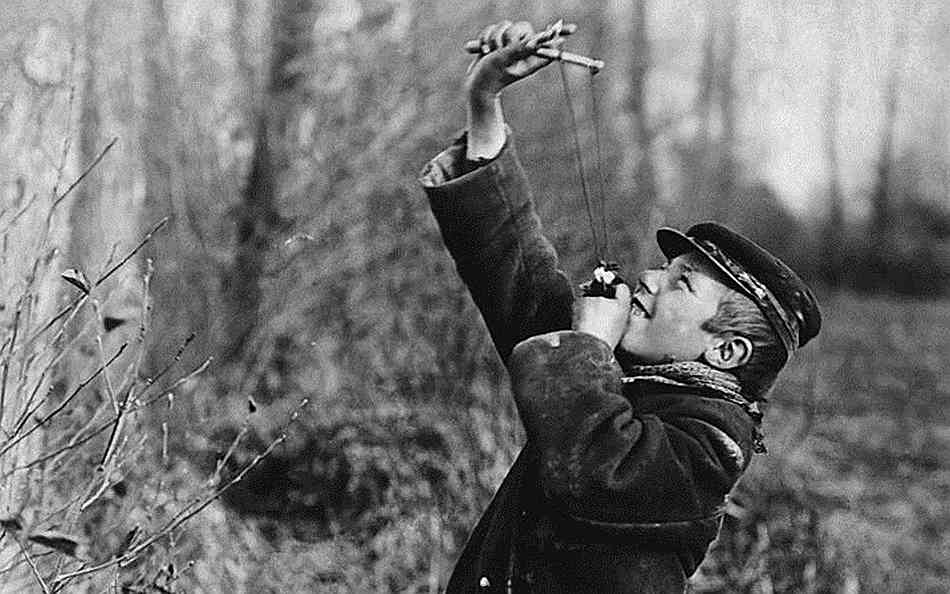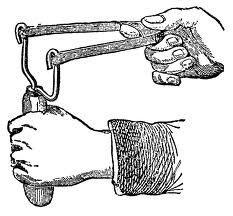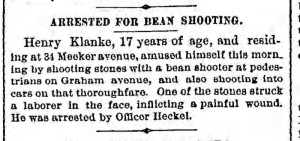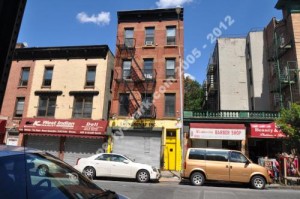SPRING BRINGS THE BEAN SHOOTERS (1863)

Brownstone Detectives investigates the history of our clients’ homes.
The story you are about to read was composed from research conducted in the course of one of those investigations.
Do you know the history of YOUR house?
********************************************************************************************************************************
There were a LOT of bad little boys in Brooklyn in the 19th century.
Sifting through old issues of the Brooklyn Daily Eagle, the Standard Union, and other Brooklyn papers, I come across evidence of this on a daily basis.
Of all the crimes that I see having been committed, one of the most common – and interesting – is the work of the “bean shooters.”
When I was a kid I had a bean-shooter myself – and I did the same thing. There were a lot of broken window panes in my neighborhood – some I was found guilty of breaking – and most others of which I got away scot free of any blame whatsoever. (There was always the suspicion, though, that I was the culprit.)
But I digress.
Let’s rewind, though – further back to the mid- to late-1800s, and take a look at the work of my fierce little boy predecessors.
BEAN-SHOOTING IN 19TH CENTURY BROOKLYN

While sling shots (or often called “slung shots”) were a constant presence in the hands of gang members and criminals (they were outlawed by the New York State Legislature in 1849), it seems that the use of such a device by boys, with any degree of consistency, did not come until some time around the early 1860s. The earliest mention in a Brooklyn paper of the use of a slingshot in the hands of a Brooklyn boy was 1863, during the Civil War. Entitled “A New Annoyance,” it was in the form of a letter to the editor, and it began thus:
“Kind Sir: You will much oblige the writer of this article by giving publicity to a growing and crying evil which now exists, and, as near as I can find out, practiced all over the city.

“While standing in my store yesterday a stone came bounding along the floor, about the size of a robin’s egg; in a moment another about the same size, struck the counter and passed my side with such force that it bounded three or four times round the room.
“I had a friend in at the time and we stepped to the door to see from whence they came, but could see no one.
“At that instant another struck the sidewalk and bounded against my store window, breaking a pane of glass, which will cost $2.50 to $3 to have it replaced.
 “I have made inquiries about the cause and find out that the boys have a sling, which they call bean-shooters, made with a stick, a string, a piece of India-rubber and a piece of leather, which can be made to throw a stone with such power as really to endanger life.
“I have made inquiries about the cause and find out that the boys have a sling, which they call bean-shooters, made with a stick, a string, a piece of India-rubber and a piece of leather, which can be made to throw a stone with such power as really to endanger life.
“Now, Mr. Editor, cannot some means be adopted to put a stop to this practice. I propose that every man that sees a boy with one of these things to immediately arrest him and take him to the station-house and have his parents sent for and not to release him without paying $5 fine. This is a growing evil and needs attention by the authorities.”
THE $5 FINE
While the practice of bean-shooting did not stop – or even slow down – a $5 fine was, indeed, placed into the Brooklyn City statutes. Section 15, article 7, chapter 8 of the Ordinances of the City of Brooklyn stated: “No person shall throw or cast any stone or other missile in, from, or to any street, lane, public place or unenclosed ground.”

In another letter to the editor of the time, the ordinance is mentioned as a penalty for being caught using a “bean-shooter.” In this 1886 missive, entitled “THE BEAN SHOOTER, A Protest From a Suffering Citizen,” the writer, who called himself “Cynic,” noted that reprimanding does nothing to stop this as the boys are not scared of being scolded. Cynic asked a policeman what could be done and he noted that “they were liable to $5 fine.”

Cynic noted that “it was a bother to arrest them,” and further asked if “adults have any rights that boys are bound to respect.”
Cynic mentioned his experience with the bean-shooters firing on his fence, and knocking out a further six panes of glass from the results of the boys firing at sparrows with their devices.
A gentleman on Bedford Avenue mentions boys “peppering the canvas screens in some of the windows until they looked like colanders,” after which “they turned their attention to the finished windows of the lower floor.” When the gentleman gave chase, the boys “retreated with marvelous promptness and dispatch.”

From the light thin panes of glass in new buildings, the boys transferred their attentions to heavier targets.
“The first one chosen to experiment on was the large plate glass window of a tailor shop in Mr. N. K. Brown’s building, 407 Nostrand Avenue.” The experiment was “a gratifying success to the boys, for the big plate glass was shivered under the first combined attack of the bean-shooter loaded with buckshot.
“The plate was worth $132 and was replaced by the Plate glass insurance company, whose agents are now looking for the boys.”
For carrying or using a bean shooter, the article noted, the penalty is a fine of $5.
But the boys continued to take their chances on being caught, as the papers continued to be as pocked with mention of the deeds of their derring-do as were their targets – with pocks.
———————————————————————————————————————–
 Brownstone Detectives is an historic property research agency. Our mission is to document and save the histories of our clients’ homes. From our research, we produce our celebrated House History Books and House History Reports. Contact us today to begin discovering the history of your home.
Brownstone Detectives is an historic property research agency. Our mission is to document and save the histories of our clients’ homes. From our research, we produce our celebrated House History Books and House History Reports. Contact us today to begin discovering the history of your home.